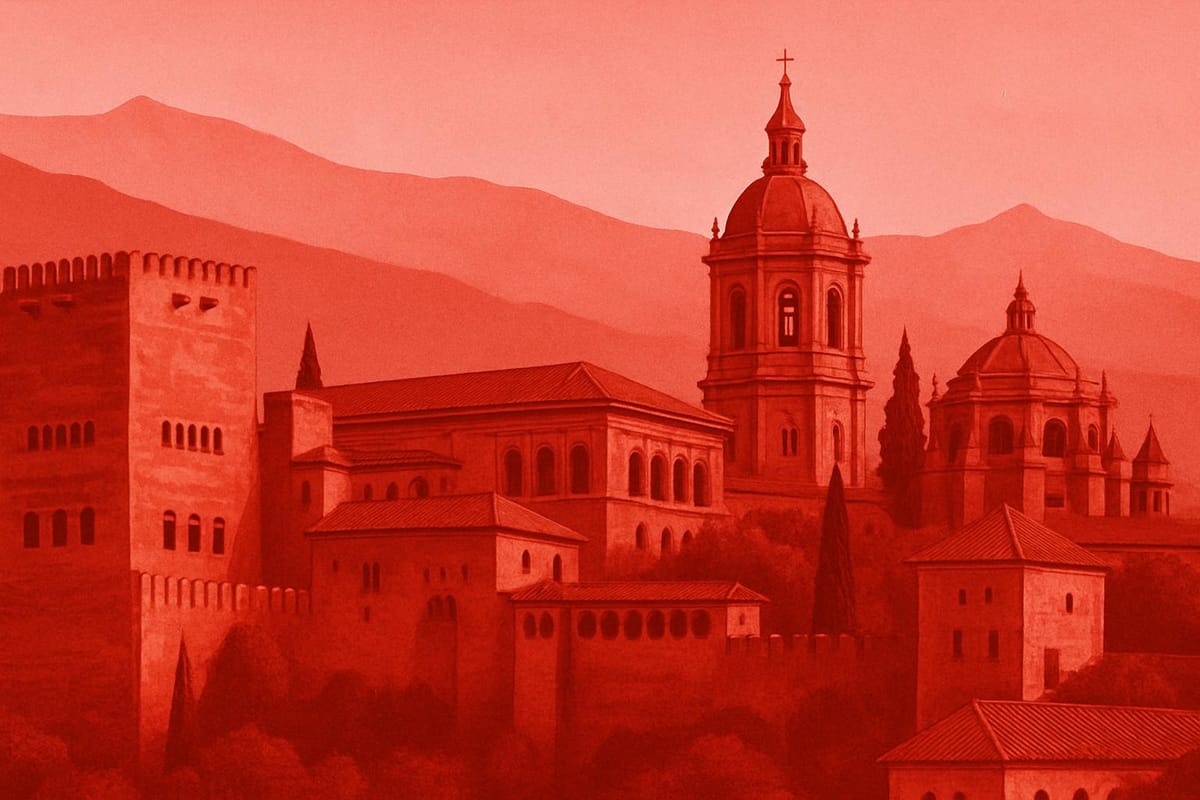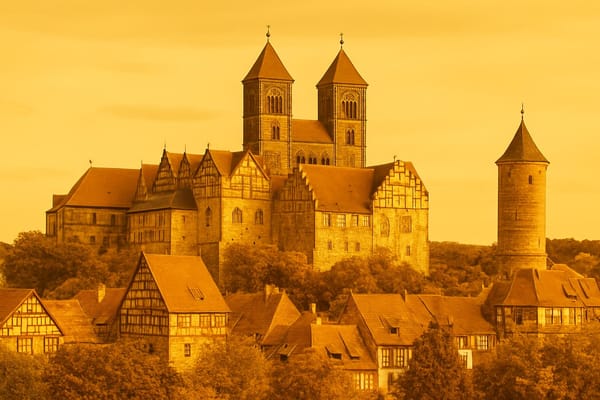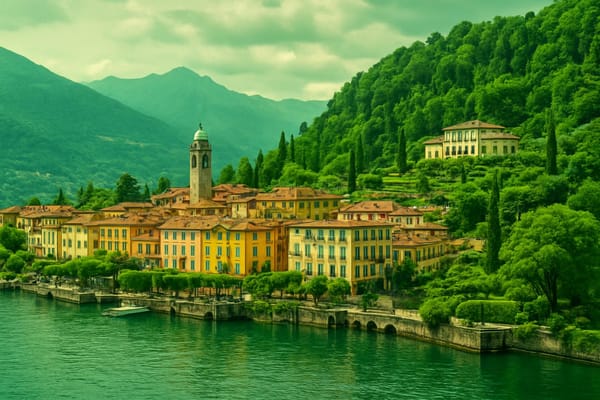Granada
Discover the Alhambra's Moorish palaces, hilltop views, flamenco nights and vibrant tapas scene.

Important things to know about Granada
Granada, Spain, is a city where the rhythms of Andalusia pulse through narrow lanes and broad avenues alike, offering a rich tapestry of history, culture, and everyday life that feels both timeless and vibrantly modern; its population blends students, artisans, and longtime residents, creating a social fabric animated by cafés, markets, and a lively culinary scene that celebrates gastronomy with generous portions of flavor and communal dining traditions. Architectural layers speak to a past shaped by diverse influences-whitewashed houses, cobblestone streets, and ornate details coexist with contemporary spaces and a dynamic university presence that injects youthful energy into local commerce and arts. The climate, with generous sunlight most of the year, encourages outdoor socializing on terraces and plazas where leisurely conversations stretch into the evening, while seasonal changes bring a different tempo to daily life, from spring festivals to quieter winter afternoons. Local craft traditions and small-scale producers contribute to neighborhoods that feel intimate and walkable, and the city’s creative scene-studios, music venues, and independent galleries-reflects both a respect for heritage and an appetite for experimentation. Transportation links and a compact urban core make the city accessible on foot or by short transit rides, and the surrounding landscape offers a striking backdrop that influences local cuisine, leisure activities, and a sense of place rooted in both land and community. For those seeking an authentic Spanish city experience marked by conviviality, cultural depth, and an atmospheric blend of past and present, Granada remains a compelling and memorable destination in southern Spain.
Sightseeing hot-spots in Granada
Granada is a jewel of Spain where history and vibrant street life meet. The centerpiece for sightseeing is undoubtedly the Alhambra, the vast Nasrid palace and fortress complex that crowns the city. Wandering through its intricately carved halls, patios and fountains gives a palpable sense of Moorish artistry and the layered history that defines Granada. Nearby, the Generalife gardens offer a fragrant escape of terraces, water channels and seasonal blooms, perfect for photography and for anyone seeking the quintessential Andalusian panorama.
For a different perspective, the old quarter of the Albaicín unfurls its maze of narrow lanes and whitewashed houses, culminating at the Mirador de San Nicolás, where sunset views of the Alhambra framed by the Sierra are unforgettable. Descend into Sacromonte to experience traditional flamenco in cave venues and the distinctive hilltop atmosphere that complements Granada’s cultural identity. The Cathedral and Royal Chapel anchor the city center with Renaissance grandeur, while bustling streets full of tapas bars invite slow exploration, making culinary discovery an essential part of sightseeing in Granada.
Beyond monuments, the surrounding landscapes and activities broaden the appeal: the Sierra Nevada mountains offer skiing and hiking within easy reach, and scenic drives reveal white villages and olive groves. Practical tips for visitors include booking tickets to the Alhambra well in advance and planning visits in the best time of morning or late afternoon to avoid crowds and capture ideal light. Whether you seek architectural splendor, flamenco nights, or mountain adventures, the sightseeing highlights of Granada deliver a richly layered Spanish experience.
Hotels to enjoy in Granada
Granada is a city where history and hospitality meet, and choosing among the many hotels in Granada, Spain can define your experience of the Alhambra, the Albayzín and the lively tapas streets. From charming boutique hotels tucked in the historic center to larger luxury hotels offering panoramic views of the Alhambra, Granada hotels cater to couples seeking romance, families needing comfort, and solo travelers on cultural trips. Many properties emphasize local character with restored Moorish architecture, inner courtyards and rooftop terraces that provide memorable sunrise and sunset moments. Practical amenities such as free Wi-Fi, on-site parking, spa services and breakfast included are common selling points, and those searching for a traditional touch will find bed and breakfast options and family-run guesthouses in the Realejo and Sacromonte neighborhoods.
When optimizing your stay, consider proximity to major attractions: being a short walk from the historic center places you close to cathedral, museums and tapas bars, while hotels near the bus station or Granada Airport simplify logistics for day trips to the Sierra Nevada. Seasonal travelers will notice differences in availability and price, so booking early for peak months when concerts and festivals fill the city is wise. Many Granada hotels offer concierge services to arrange Alhambra tickets, guided tours, and ski transfers to the Sierra Nevada, enhancing convenience. Whether you prioritize a rooftop terrace with Alhambra views, a quiet courtyard for relaxation, or a budget-friendly base for exploring, Granada’s accommodation scene delivers options that blend authentic Andalusian charm with modern comforts.
Restaurants to try in Granada
Granada has a vibrant dining scene where tapas culture meets contemporary kitchens, and every street seems to lead to a surprising restaurant filled with flavor. In neighborhoods like the Albaicín and Realejo, bars and family-run taverns serve generous plates that celebrate Andalusian cuisine and the region’s local produce, from fragrant olive oil to mountain cheeses and fresh seafood. Dining in Granada often becomes a sensory experience: small plates paired with local wines, charming Carmen patios, and views of the Alhambra at dusk create memorable meals that visitors and locals cherish. Whether you’re looking for cozy, authentic tapas bars where a drink comes with a complimentary bite, or more modern concepts blending traditional recipes with avant-garde techniques, Granada’s restaurants offer a breadth of options for every palate and budget.
For travelers seeking curated gastronomy experiences, Granada’s restaurant landscape includes everything from rustic bodegas to sleek venues pushing modern Spanish flavors, making it a destination worth exploring for food lovers. The emphasis on seasonal ingredients and Andalusian culinary traditions ensures that menus change with the harvest, and many establishments proudly showcase sustainable practices and regional wines. Search terms like restaurants in Granada, Granada Spain restaurants, and tapas in Granada will uncover a mix of hidden gems and well-known tables; booking in popular areas or during high season helps secure a spot at the most sought-after places. Ultimately, dining in Granada is as much about the atmosphere - lively streets, friendly service, and historic surroundings - as it is about the dishes, so plan to savor both the food and the cultural backdrop that makes this city’s restaurant scene so engaging.
Best shopping stops in Granada
The vibrant shopping in Granada blends centuries of history with contemporary style, making it a must-visit for anyone looking for unique Granada souvenirs and artisan treasures. Wander through the narrow lanes of the Alcaicería, where silk-inspired textiles, intricate ceramics and hand-painted tiles recall the city's Moorish past, or explore Calle Elvira and the Realejo neighborhood for independent boutiques offering leather goods, bespoke jewelry and avant-garde fashion. The city's shopping highlights include a mix of traditional handicrafts, flamenco dresses and modern design stores - perfect for travelers searching for “best shopping in Granada” experiences. Close to the Alhambra, you'll also find galleries and specialty shops selling local olive oil, spices and gourmet items that reflect Granada’s culinary richness, making shopping here both a cultural and tasty exploration.
Markets and hidden gems add another layer to Granada shopping scene, with places like the Mercado San Agustín showcasing fresh local produce alongside artisanal stalls where you can buy ceramics, silverwork and handmade cosmetics. Local artisans often open small workshops, so visitors can watch the creative process and pick up truly authentic pieces. For those optimizing a trip, combine shopping with sightseeing - afternoons of browsing shops followed by tapas in historic plazas are quintessential Granada activities. Practical tips for a seamless shopping experience include checking opening hours for small boutiques, asking sellers about provenance to ensure authenticity, and searching out local markets for bargains. Whether you’re hunting for unique souvenirs in Granada or high-quality artisan crafts, the city’s diverse retail offerings make it a rewarding destination for shopping lovers and culture seekers alike.
Nightlife highlights in Granada
Granada nightlife pulses with a unique blend of historic charm and modern energy, drawing both locals and visitors into streets that come alive after sunset. From the winding alleys of the Albaicín to the panoramic terraces overlooking the Alhambra, evenings in Granada offer unforgettable moments: cozy tapas bars where complimentary bites accompany drinks, lively plazas such as Plaza Nueva filled with chatter, and intimate flamenco shows that capture Andalusian soul. Whether you’re hunting the best bars for craft cocktails, seeking a traditional cave performance in Sacromonte, or simply strolling past lit-up monuments, the nightlife in Granada blends culture and conviviality in a way that keeps visitors exploring until the early hours.
Late-night options in Granada cater to every taste, from relaxed wine bars to energetic clubs playing electronic and Latin beats, making it easy to experience the full spectrum of Andalusian nocturnal life. Food-focused nights transition into dance-filled early mornings, and you’ll find local rhythms and international influences woven into the scene. For those researching Granada nightlife, keywords like tapas culture, flamenco in caves, Albaicín viewpoints, and late-night bars often guide travelers to the most memorable experiences, ensuring a vibrant, authentic night out in this historic Spanish city.
Getting around in Granada
Granada offers convenient air and rail links that make it easy for travelers to reach the Alhambra and the city center: the Federico García Lorca Granada-Jaén Airport (GRX), located about 15–20 km from Granada, handles regular domestic flights and a growing number of seasonal international services, while bus shuttles, taxis and private airport transfers provide quick links into the city and nearby towns; on the rail side, the Estación de Granada connects the city to Spain’s national network with AVE high-speed trains and Renfe services, cutting travel time to Madrid to roughly three hours and offering convenient connections via Antequera to Málaga and the rest of Andalusia, plus regional options toward Almería and Jaén, so visitors can choose fast long-distance travel or regional trains depending on their itinerary; both airport and train station are integrated with local public transport and car rental services, making it straightforward for tourists and business travelers to plan smooth transfers, book onward connections, and optimize travel times when exploring Granada and the surrounding region.
Culture must-see's in Granada
Granada is a living museum where the Alhambra and the lush Generalife gardens stand as the most iconic culture highlights of Granada, Spain. Walking through the palace complex you feel the layered history of Andalusia, where intricate Islamic tilework and serene courtyards speak to centuries of Moorish influence. From the hilltop Mirador de San Nicolás you can admire the Alhambra at sunset framed by the Sierra Nevada, while the winding streets of the Albaicín reveal whitewashed houses, artisan shops, and intimate tea houses that celebrate the city's multicultural past. Cultural life here is not confined to monuments: the Cathedral and the Royal Chapel showcase Renaissance and Gothic artistry, and museums and galleries around the city present contemporary Andalusian creativity alongside historical treasures.
Food, music and festivals are central to Granada’s cultural identity, making it rich in sensory experiences. The city's famed tapas culture-where ordering a drink often brings a free snack-turns every evening into a social celebration, while flamenco pulses in the caves of Sacromonte, where gypsy traditions preserve a raw and emotional art form. Seasonal events like Semana Santa and local patron saint festivals bring processions, costumes, and communal gatherings that invite participation. For visitors seeking relaxation rooted in tradition, historic hamam baths offer aromatic steam rituals that echo Moorish wellness practices. Together these elements-monumental heritage, lively gastronomy, flamenco soul and vibrant street life-make Granada, Spain a top cultural destination for travelers eager to experience the heart of Andalusian history and contemporary living.
History of Granada
Granada's long and layered past began well before the famous palaces and gardens that draw visitors today. Positioned between the fertile plains of Andalusia and the rugged peaks of the Sierra Nevada, Granada became a crossroads of cultures on the Iberian Peninsula. After periods under Iberian, Roman and Visigothic influence, the city was transformed following the early 8th-century Islamic conquest, eventually emerging as the capital of the Nasrid Kingdom in the 13th century. Under rulers like Muhammad I ibn al-Ahmar, the Alhambra palace complex and the serene Generalife gardens were conceived and developed into masterpieces of Moorish architecture and ornamental art-exquisite stucco, intricate tilework and water features designed to reflect a sophisticated blend of aesthetics, engineering and Islamic cosmology. The medieval neighborhoods of the Albaicín and the Sacromonte preserved a dense urban fabric of narrow streets, whitewashed houses and artisan workshops where silk, ceramics and scholarly pursuits flourished; this period defined much of what people associate with the classical history of Granada and gave the city a reputation as a center of learning, religious scholarship and multicultural exchange.
The seismic change in Granada’s destiny came in 1492, when the city was surrendered by the last Nasrid ruler, Boabdil, to the Catholic Monarchs, Isabella and Ferdinand, marking the completion of the Reconquista and a decisive shift to Christian rule. The subsequent centuries saw a complex process of religious conversion, cultural blending and social upheaval-mosques were repurposed as churches, Mozarabic and Renaissance influences merged into new civic and religious architecture, and institutions such as the University of Granada (established in 1531) helped anchor the city within the evolving Spanish kingdom. Later policies, including the expulsion of the Moriscos, caused demographic and economic shifts, but Granada remained a vibrant repository of hybrid traditions. In modern times, the city’s layered past has been recognized as world heritage-most notably the Alhambra, Generalife, and the Albaicín-and tourism, scholarship and preservation efforts have turned Granada into a leading destination for those seeking the living narrative of Granada history, the artistic legacy of the Nasrid era and the enduring cultural fusion that defines this emblematic city of Spain.



